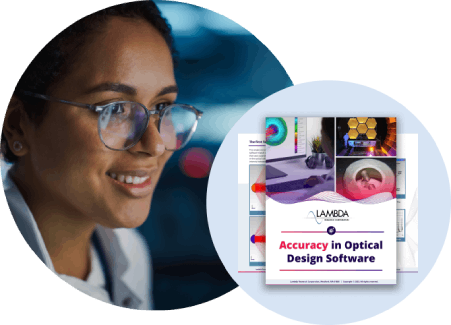What are OSLO's features?
OSLO is a large program, with thousands of internal commands and functions. Moreover, the executable module of OSLO is routinely modified and recompiled by users. As a result, it is not possible to give a complete list of specifications for what the program can do. The links in the list below provide a survey of the features in OSLO, but OSLO has many more capabilities. If you have a question about a specific capability, explore our web site or contact Lambda Research directly. View the OSLO Brochure in pdf format. OSLO's major features include
- Lens and Material Databases
- Special Surface Data
- Zoom and Multiconfiguration Systems
- Arrays and Non-Sequential Groups
- Special Apertures
- Tolerance and Element Data
- Polarization and Thin Film Coatings
- Ray tracing
- Diffraction and Partial Coherence
- Optimization Methods
- Tolerance Analysis
- Lasers, Fibers, and Gaussian Beams
- Illumination Analysis
- Perfect Lenses and Eikonals
How does OSLO compare to other software?
Although many optical design programs appear to be similar, there are big differences in their capabilities and design approaches. OSLO is a mainstream optical design program that has consistently shared top honors in optical design contests. Although OSLO has a heritage that traces back to the early 1960's, in its current implementation it is an object-oriented windows program, with a unique built-in application manager/compiler that provides extremely high performance on desktop computers.
What are OSLO's strong points?
Designer-Oriented Design. OSLO stresses interactive optical design, in which the computer provides easily understood feedback to the designer. This allows the designer to make critical trade-off decisions that produce superior solutions. OSLO is unique in its use of interactive design controls that make the user interface intuitive to use. Power and Accuracy. OSLO uses advanced optical design technologies, including a selection of optimization and tolerancing methods, high-performance non-sequential ray tracing, and stochastic source modeling and analysis. OSLO was the first program used for serious optical design on desktop computers, and it has been developed far more extensively than other software. Flexibility. A prime reason that OSLO has become the tool of choice for leading designers around the world is that it is easy to customize and adapt the program to specific needs. The reason for this is that OSLO uses advanced software technologies to bring the power of Windows into the realm of technical computing. IIn fact, the CCL language supplied with OSLO compares to Python, Java, or Visual Basic for Applications rather than to the simple macro languages supplied with other optical design software.

